Thanks to the chrysanthemums, there is still a lot going on in the garden in autumn. Here are helpful tips for the proper care of chrysanthemums.

Chrysanthemums (chrysanthemum) enrapture the heart of every garden lover again in autumn. Those of the daisy family (Asteraceae) is one of the last to flower, but with its colorful, simple to double flowers it is in no way inferior to the plants of earlier seasons. On the contrary, they are unrivaled due to their late flowering and round off the autumnal overall picture of every garden or balcony, especially in warm copper tones. Nevertheless, they are extremely undemanding garden dwellers that you can usually enjoy for years with the right care and minimal winter protection.
contents
- Chrysanthemums: meaning and origin
-
Chrysanthemums on the balcony and in the garden
- The right location for chrysanthemums
- Chrysanthemums in a pot
- Repot chrysanthemums
-
Care for chrysanthemums properly
- How often do chrysanthemums need to be watered?
- How often do chrysanthemums need to be fertilized?
- When and how to prune chrysanthemums
-
Are chrysanthemums actually perennial?
- Successfully wintering chrysanthemums
- Caring for chrysanthemums after winter
Chrysanthemums: meaning and origin
The name chrysanthemum is derived from ancient Greek and means "the gold blossom" or "gold flower". Giving away a chrysanthemum signals that my heart is free. In Japan, the chrysanthemum is considered the national flower. The Chrysanthemum Order is one of the highest awards there. In China, the plant represents prosperity and happiness, while in France it represents death and mourning. This important autumn bloomer originally comes mainly from East Asia (China, Korea, Japan, Russia). In China, the garden chrysanthemum (chrysanthemum × morifolium), a hybrid of different species, cultivated for 1600 years. It is considered one of the most important horticultural crops, which is also reflected in the thousands of cultivars. The pretty flowers are even good for the eyes in two respects, because in Ayurveda medicine they are used to treat eye inflammation and skin impurities. In rare cases, however, contact with the plant parts leads to allergies and skin irritations.

When are chrysanthemums in bloom?
The solitary inflorescences are cup-shaped and usually bloom in autumn from September to November. The female ray florets with their pink to red or yellow tongues are distinguished from the hermaphrodite tubular florets, which shine in yellow. In the meantime, cultivars also offer other colors as well as multicolored and double flowers. Incidentally, varieties in pink and violet tones bloom the longest.

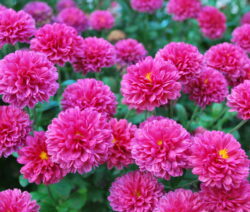
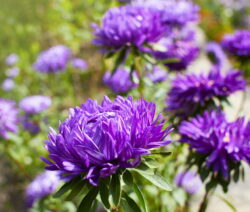
Notice: Flowering can be stimulated and thus pushed forward by briefly covering the plants in summer to simulate shorter days. Because the flowering begins as in Christmas star only after the equinox.
Chrysanthemum indicum: The autumn chrysanthemum in your own garden
the Autumn Chrysanthemum (Chrysanthemum indicum) is wonderfully suited for planting out in the garden due to its good winter hardiness. This perennial species blooms in our latitudes from August to November and comes in a wide variety of colors depending on the variety. So your perennial border can give everything again in autumn. The following should be considered when planting:
- Location: Sunny and sheltered from the wind
- soil: garden soil; nutritious; permeable
- Planting time: Spring to early summer (March - May)
You can do something good for bees with single-flowering autumn chrysanthemums, because they serve as a late food source. More information on the autumn chrysanthemum and other decorative ones Chrysanthemum Species find here.

Chrysanthemums on the balcony and in the garden
If the chrysanthemums are to be planted in the garden, it is best to use the more robust garden or autumn chrysanthemums. These can be overwintered outside with the right protection. Planting time here is May so that the plants have enough time to establish themselves properly in the soil before winter. Potted chrysanthemums that are more sensitive to frost are also suitable for the balcony, but they prefer to migrate to a protected winter quarters in the cold season. The difference is not only in the different winter hardiness of the varieties, but also in the rearing of the autumn bloomers. While pot chrysanthemums are grown in the greenhouse, the garden variety grows outdoors. This not only affects resilience, but encourages a longer flowering period with intensely colored buds.

The right location for chrysanthemums
Whether on the balcony or in the garden, the plants feel comfortable in a suitable spot and give you their full bloom in autumn. The following applies here:
- Location: Sunny to semi-shade; dry; sheltered from the wind
- Soil: rich in nutrients; permeable; calcareous; not too dry or too wet
A dry and wind-protected place is particularly important if the plants are to be overwintered outside. Here, for example, a protected spot on the house wall is suitable. In the case of less permeable soils, winter wetness in particular can become a problem. Lay out a drainage layer of gravel or broken pottery or loosen the soil by mixing in sand. You can combine them with grasses or other late bloomers as you wish. Keep the distance between plants small, because chrysanthemums only grow sparsely after planting.

Chrysanthemums in a pot
Chrysanthemums are one of the last flowering plants of the year and thus extend the flowering garden season even further. In order for the autumn flowers to grow into a real ornament on the balcony, terrace or even as a houseplant, the following must be observed:
- Substrate: Flower, vegetable or herb soil
- pot: drain pipe; Drainage layer (gravel, potsherds)
- Location: No direct sun
It is particularly important to create good water drainage for the plants that are sensitive to waterlogging. Do not place the pot or bucket on a saucer so that excess water can drain off easily. In addition, the flowers are only hardy to -2 °C. If there is a risk of frost, place the pot inside overnight. After flowering, perennial chrysanthemums are cut back to just above the ground and overwintered in a sheltered winter quarters. This also applies to indoor chrysanthemums, because the plants also need their hibernation. Alternatively, the chrysanthemums can be planted uncut in the bed after flowering. Specimens planted in this way should come back even better the next year than those left in the pot. When planting, just make sure the ground isn't frozen.
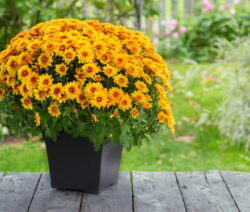
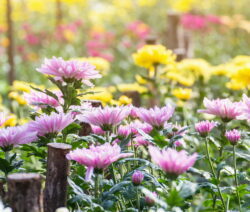

Notice: Chrysanthemums are also suitable as houseplants, particularly because they are undemanding in terms of the given lighting conditions. They even thrive on a north-facing window.
Repot chrysanthemums
Perennial chrysanthemums have to be repotted every now and then, because they reproduce through runners and root through the pot quite quickly. For a compact growth is repotted and thinned out every two years. If you want to save yourself the additional fertilization, put the plant in new soil once a year after it has overwintered.
Care for chrysanthemums properly
Chrysanthemums are easy to care for and, depending on the variety, extremely robust. You only need a little finesse when watering the plants, which are sensitive to waterlogging.
How often do chrysanthemums need to be watered?
Chrysanthemums need a lot of liquid, especially when they are in bloom. Water during the growing season as soon as the soil has dried out on the surface. Daily watering is therefore essential on summer days. Watering is also done on rainy days, because the plants often grow very densely, which is why usually not enough water gets to the roots. The soil is kept evenly moist. Make sure that the plant never stands in water. Despite the high water requirement, waterlogging is very poorly tolerated and quickly leads to root rot. In addition, chrysanthemums are always watered from below so that the risk of fungal attack is not increased by wet leaves and flowers. In winter, during the dormant period, only water so that the soil does not dry out completely.
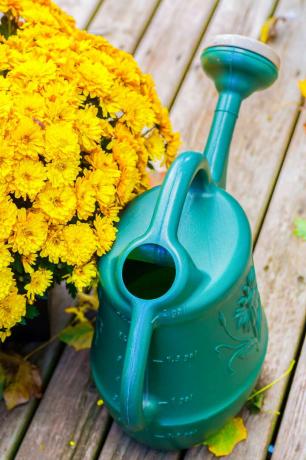
How often do chrysanthemums need to be fertilized?
As far as the demand for nutrients is concerned, chrysanthemums are very frugal despite their autumnal blooms. Annual pot chrysanthemums do not need to be fertilized at all. They are satisfied with what the fresh potting soil has to offer. In the case of perennial specimens, the soil is renewed after hibernation or from April to September from the second year with an organic liquid fertilizer like ours Plantura Organic Flower & Balcony Fertilizer or fertilized with compost. One of the advantages of using an organic fertilizer instead of a mineral one is that soil life is encouraged. A healthy microbiome is important for the well-being of your green companions, especially in the limited space of a pot. If you have perennial chrysanthemums in the bed, use compost or a granular organic fertilizer like ours in the spring Organic flower fertilizer fertilized with long-term effect.
When and how to prune chrysanthemums
By itself, only perennial chrysanthemums need pruning. The shoots of the pot chrysanthemums are cut back about a finger long after flowering. In the bed, the plants are only cut back to a quarter after the winter and dried parts of the plant are completely removed. This gives the plant additional protection from the cold temperatures. In addition, faded inflorescences should be cleaned regularly. This ensures a longer lasting bloom. This also applies to annual varieties. In addition, an occasional pruning promotes a nice, bushy and low growth.
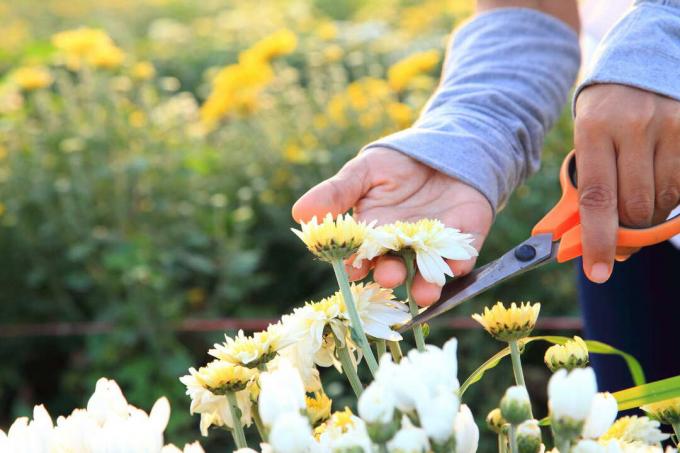
Summary: Proper care for chrysanthemums
- Watering in the vegetation phase: when the substrate has dried out on the surface
- Watering in winter: The substrate should not dry out completely
- Fertilize potted chrysanthemums: Not in the first year, then from April to September with organic liquid fertilizer or compost
- Fertilize garden chrysanthemums: in spring with compost or organic fertilizer in granular form
- Cut potted chrysanthemums to finger length after flowering
- Prune garden chrysanthemums: After wintering to ¼; remove dried shoots
Are chrysanthemums actually perennial?
Chrysanthemums are perennials, but not all varieties are hardy. Especially chrysanthemums from supermarkets, discount stores, DIY and garden centers wither at temperatures below -5°C and therefore often end up on the compost after flowering. Even if the supply of hardy garden chrysanthemums there increases from year to year, it is worth going to a knowledgeable perennial nursery or breeder.



Successfully wintering chrysanthemums
Chrysanthemums in the bed are covered with a protective layer of coniferous branches before the first frost. Leaves or straw should not be used with chrysanthemums, because too much moisture is stored here and the chrysanthemums begin to rot. Watering is only done on frost-free days. The potted chrysanthemums cut back after flowering are overwintered in a light and cool place, but frost-free. The temperature should be no more than 10 °C. An unheated greenhouse or conservatory is best. A spot in a bright basement, stairwell or in the gazebo is also sufficient. Alternatively, pot chrysanthemums can be overwintered outside in a large pot in areas with mild winters. For this purpose, the pot is wrapped in several layers of newspaper or bubble wrap, or the chrysanthemum is planted with the pot in the bed. In April, your chrysanthemums can then be taken outside again or unpacked.

Caring for chrysanthemums after winter
After the winter, when the temperatures are milder again, garden chrysanthemums are cut back. From March, all shoots are cut back to a quarter with clean, sharp pruning shears and withered parts of the plant are cut off just above the ground. The new shoots are not injured if possible. Potted chrysanthemums get new soil and sprout happily again. Alternatively, the fertilization is adjusted.
In addition to chrysanthemums, there are a few other types of flowers that brighten up autumn for us. Here you will find an overview of the most beautiful ones Autumn flowers for the garden.



